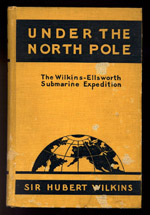 |
| Crew of the Nautilus on an ice floe |
From the first efforts to locate the Northwest Passage in the 17th century to the flowering of arctic studies in the mid-20th century, European and American explorers and scientists have made repeated efforts to reach the North Pole. Traveling by ship and dogsled, Admiral Robert E. Peary, USN, became the first to reach the Pole on April 6, 1909, after which other explorers outdid one another in efforts to reach the top of the world. Most famously, on May 9, 1926, Admiral Richard E. Byrd, USN, became the first to fly over the North Pole.
 |
| Sir Hubert Wilkins, Under the North Pole ([N.Y.] : Brewer, Warren, & Putnam, 1931) |
In 1931, Australian explorer Sir George Hubert Wilkins and a volunteer crew of submariners and scientists set out in a decommissioned U.S. Navy submarine to sail under water from Spitsbergen to the Bering Straits by way of the North Pole. Before departing on his expedition, which he estimated would take 42 days, Wilkins published a promotional book,
Under the North Pole, both to raise funds and as a record of the expedition's goals in case no one should return. In his book, Wilkins states that he was undertaking this expedition not only because it had never been done, but as a means of opening "a new field of Arctic research that needs explaining"(page v). The mission was championed as a scientific expedition, featuring valuable experiments in oceanography, the sampling of the Arctic seabed, taking gravity measurements, biological investigations, and magnetic and spectrographic observations. Wilkins provided much of the financial support for the expedition from his own pocket, supplementing the total by raising funds from private individuals. He received scientific support from such institutions as the Carnegie Institution of Washington, the Woods Hole Oceanographic Institution, the Norwegian Geophysical Institute, the American Geographical Society, and the Cleveland Museum of Natural History, however even this impressive list of supporters did not prevent people from seeing the trip as nothing more then a publicity stunt, even some in the crew. This perception was probably the result of Wilkins's contract with Hearst Enterprises, Inc., to provide exclusive daily news reports for the New York
American. In many eyes, the failure of the expedition to complete most of their scientific experiments only confirmed the perception.
 |
| The Nautilus surfacing near ice floes |
Despite Wilkins's noble intentions, a late start and repeated mechanical problems prevented the
Nautilus from ever reaching the North Pole. This exhibit recounts Wilkins's expedition through the photograph scrapbook of Frank Blumberg, a Navy veteran and Chief Electrician on the expedition. His family donated Blumberg's scrapbook, consisting of both press and private photographs and related ephemera, to the American Philosophical Society in 1990. The
Nautilus collection represents a small part of the material the American Philosophical Society Library holds on Arctic exploration, including the papers of Franz Boas (Baffinland expedition of 1883), Henry Bryant Grier (a geographer and member of the Arctic Club), Robert Fitzroy (the hydrographer), William Parker Foulke (a Philadelphia supporter of Elisha Kent Kane), and Henry Goodfellow (a sailor aboard Kane's voyage in the
Advance). The largest arctic collection at the APS relates to Elisha Kent Kane, a naval surgeon, explorer, and member of the Society, who participated in the 1850 expedition to rescue Sir John Franklin. From 1853 until 1855 Kane undertook his own Arctic expeditions, becoming the United States' first arctic hero.
Sources consulted






